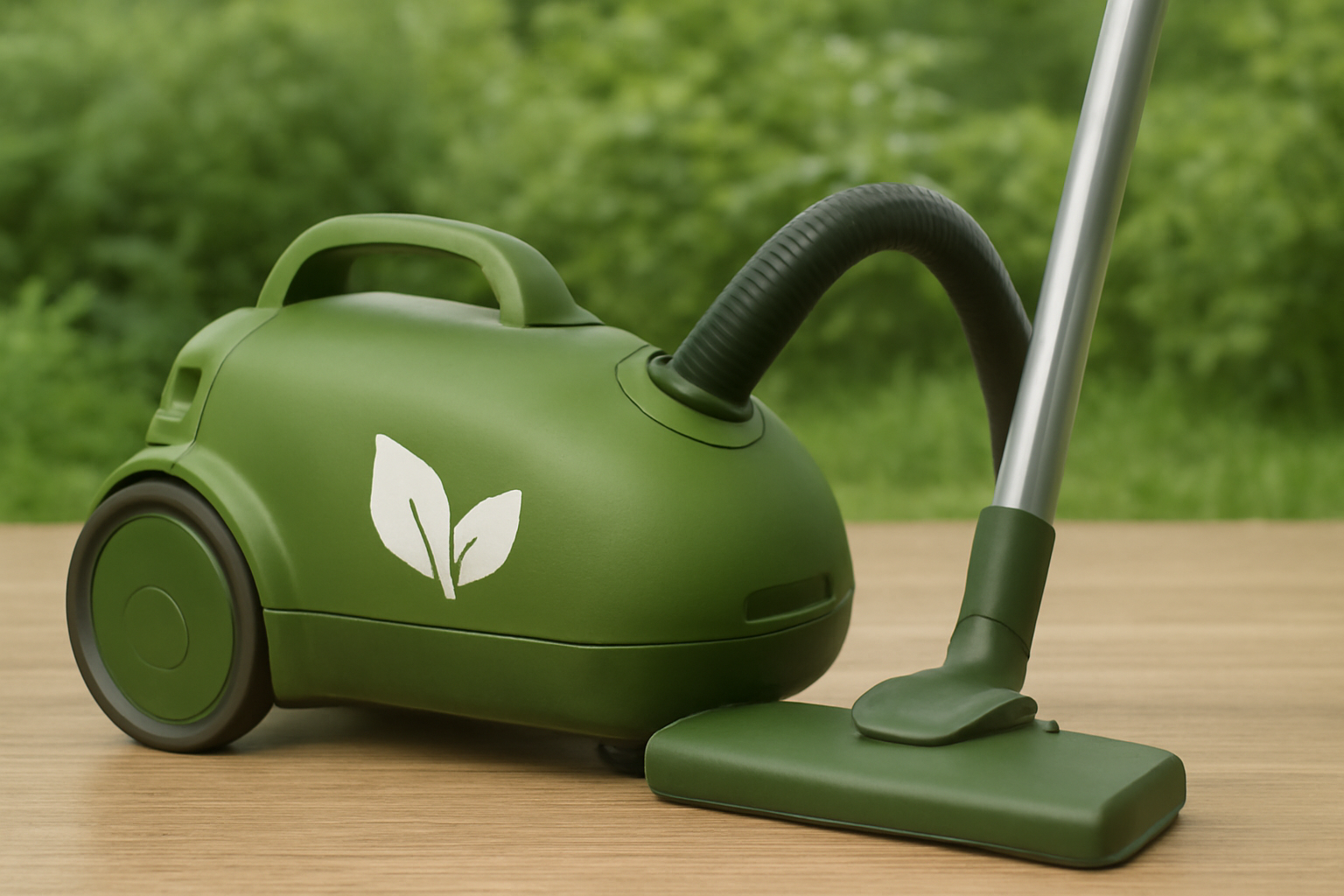
🌿 Introduction
Environmental responsibility has become a defining feature of Europe’s consumer-goods landscape. Within the home-appliance category, vacuum cleaners illustrate how sustainability moves from a marketing claim to a concrete purchasing requirement. Importers, distributors, and procurement specialists across Europe increasingly evaluate products through the lens of energy efficiency, recyclability, and lifecycle impact.
The shift is structural: buyers no longer treat “green” as optional. Instead, it determines market access, compliance with EU directives, and long-term profitability.
♻️ 1. From Regulation to Market Expectation
Europe’s Eco-design Directive and the Energy Labeling Regulation have placed measurable limits on energy consumption and noise levels for cleaning appliances. Importers who once relied on cost competition now differentiate through sustainable sourcing and transparent documentation.
Governments reinforce these policies with fiscal incentives for low-energy devices and with restrictions on single-use plastics. This environment compels manufacturers to rethink component materials, packaging, and service models that extend a product’s useful life.
⚙️ 2. Engineering for Environmental Efficiency
Technical innovation underpins sustainability. Motor efficiency, airflow optimization, and modular construction allow engineers to reduce wattage without sacrificing performance. Lightweight structural materials such as aluminum and reinforced polymers cut transport emissions and improve ergonomics.
Recyclable housings and easily separable components simplify end-of-life processing. A single design change—like using standardized screws instead of adhesives—can make the difference between full recyclability and landfill waste.
These considerations now appear in tenders and vacuums procurement documents throughout the EU, proving that sustainability metrics have become part of professional purchasing language.
🔋 3. Power Management and the Rise of Cordless Models
Cordless designs fit neatly into the sustainability narrative. Modern lithium-ion batteries enable energy-optimized cleaning sessions and reduce household electricity demand. While battery production carries its own footprint, improvements in cell recycling and extended service programs are mitigating concerns.
Western consumers appreciate the convenience, but importers view cordless systems as compliance-friendly products that meet updated efficiency thresholds. Many retailers label them as “low-impact” or “eco-smart,” encouraging repeat orders from environmentally conscious households.
🌐 4. Supply-Chain Transparency and Traceability
European distributors now expect real-time data on material origins, carbon intensity, and manufacturing standards. Digital product passports—scheduled for rollout under the EU’s Circular Economy Action Plan—will require detailed environmental declarations.
This affects how suppliers manage vacuum cleaner distribution across borders. Transparent logistics chains that document shipping emissions and warehouse energy use are becoming prerequisites for long-term contracts.
Such traceability reshapes the relationship between manufacturers and importers: compliance is verified continuously, not just at certification.
🧹 5. Innovation Example: Portable Self-Cleaning Systems
Technological convenience and sustainability often reinforce each other. The Portable Self-Cleaning Vacuum Cleaner is a case in point. Its self-maintenance mechanism reduces water use and extends brush life, minimizing waste from consumable accessories.
For distributors, the model demonstrates how eco-design can align with hygiene and labor savings. In procurement scoring, fewer disposable parts and longer component durability directly improve sustainability ratings.
💪 6. Durability as a Sustainability Metric
European policy now frames durability as environmental performance. A Multi-Functional Durable Vacuum Cleaner supports multiple cleaning tasks with a single motor unit and modular attachments, lowering the overall consumption of materials.
Durability also reduces reverse logistics costs for importers, since fewer warranty returns translate to smaller carbon footprints. By quantifying longevity—using tests for motor cycles and battery recharge counts—suppliers can offer measurable evidence of sustainability rather than relying on slogans.
🚛 7. Green Logistics and Packaging Reform
Transportation accounts for a significant portion of emissions in appliance distribution. Many importers collaborate with logistics providers to consolidate shipments, use low-emission vehicles, and replace foam packaging with molded pulp.
Warehouse energy audits and solar installations increasingly appear in tender documents. Small efficiency gains, multiplied across thousands of units, create tangible reductions in Scope-3 emissions—helping distributors meet corporate ESG goals.
🌍 8. European Importer Perspective
Interviews with procurement managers highlight three decisive factors:
Documentation quality—accurate test reports and carbon data.
Repairability—availability of spare parts for at least seven years.
Consumer education—clear information on cleaning modes and energy use.
Importers view suppliers who meet these expectations as long-term partners rather than transactional vendors. This strategic collaboration underlines how sustainability fosters supply-chain stability.
🧭 9. Middle Eastern Connections
While Europe sets standards, Middle Eastern distributors are quick to adapt. High dust loads and extended operating times demand robust filtration systems, and eco-efficiency translates into reduced energy bills. Regional buyers look to European specifications as benchmarks, using them to evaluate upcoming tenders and private-label opportunities.
📊 10. Data-Driven Forecast
Analysts expect that by 2030, over 80 % of vacuum cleaners sold in the EU will carry explicit sustainability claims validated by third-party audits. Growth segments include energy-efficient motors, recycled materials, and take-back schemes.
Manufacturers investing in lifecycle design tools and circular-economy logistics will find themselves aligned with both policy direction and consumer preference.
🌟 Conclusion
Sustainability has moved from aspiration to obligation. Eco-friendly vacuum cleaners succeed not only because consumers favor them but because importers require them. Compliance frameworks, resource efficiency, and transparent documentation now determine market entry.
As the industry transitions, environmental performance equals business performance. The brands and distributors that internalize sustainability as a design principle—rather than a sales slogan—will shape the next decade of the European home-care sector.
📌 Hashtags
#SustainableAppliances #EcoFriendlyVacuum #CordlessVacuum #EnergyEfficientCleaning #CircularEconomy #GreenProcurement #EcoDesignDirective #SmartHomeAppliances #LowEnergyMotor #RecyclableMaterials #GreenLogistics #Repairability #VacuumInnovation #HomeCareTechnology #WasteReduction #BatteryRecycling #ErgonomicDesign #LightweightAppliance #PortableVacuum #QuietVacuum #VacuumsProcurement #VacuumCleanerDistribution #PortableSelfCleaningVacuumCleaner #MultiFunctionalDurableVacuumCleaner #RenewableEnergyUse #CarbonNeutralSupplyChain #PackagingReform #SustainableDistribution #HomeTechInsights #RecycledPlastics #EcoSmartLiving #SmartManufacturing #SustainableSupplyChain #EnergyLabel2025 #ConsumerAwareness #HomeApplianceTrends #EcoCertification #DurableDesign #CleanAirTechnology #SmartCharging #GreenRetail #HouseholdEfficiency #SustainabilityGoals #ModernHousehold #EUCompliance #MarketForecast2030 #B2BProcurement #EcoInnovation #VacuumForMultiSurface #VacuumCleanerForAllergies #CarVacuumCleaner #Lanxstar
















